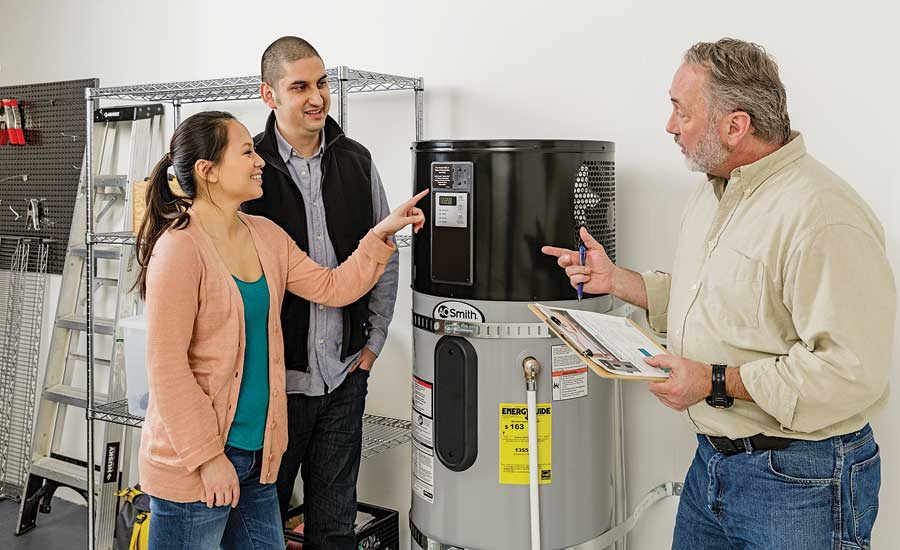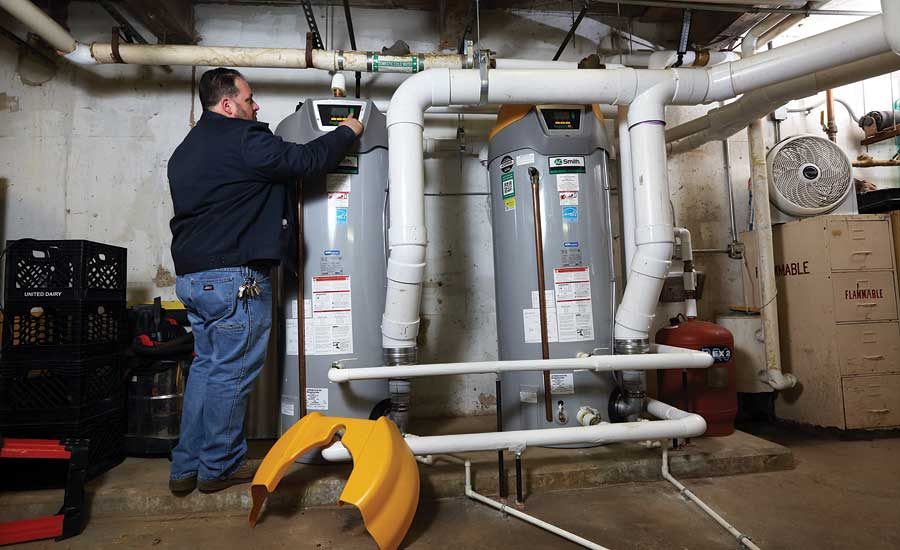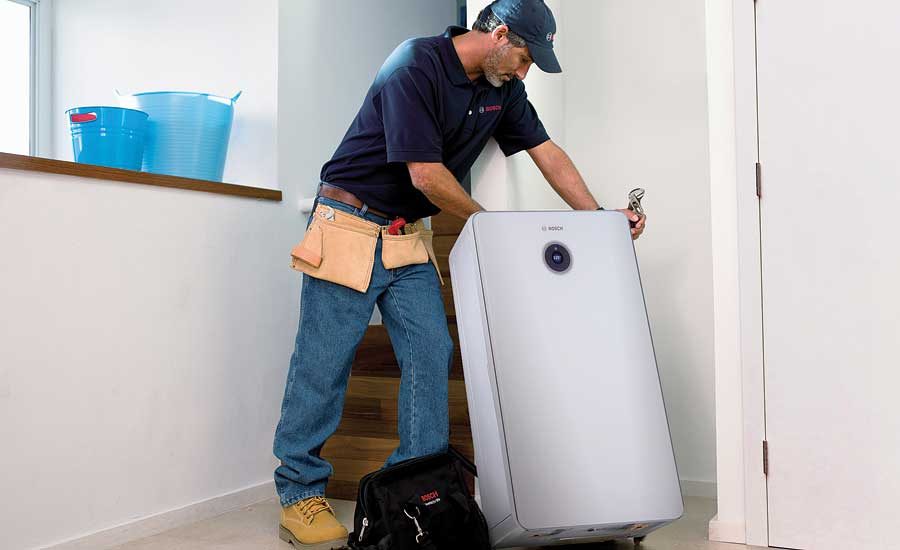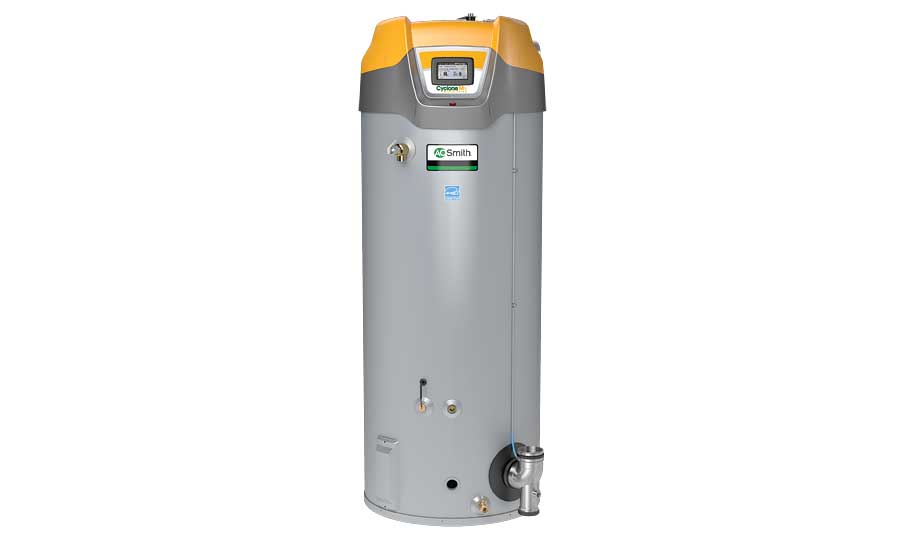Regulations, IoT influence water heater trends
With tankless technology increasing in popularity, homeowners have a wide variety of options available to them.

A. O. Smith’s Voltex Hybrid Electric Heat Pump residential water heaters are continuing to gain in popularity. Photo credit: A. O. Smith

A. O. Smith and other manufacturers work closely with installers to ensure their units are easy to install and service. Photo credit: A. O. Smith

Navien NPEs can be installed with common venting using PVC. Photo credit: Navien

Bosch Thermotechnology Corp. designed the Greentherm900 tankless water heater series with the installer in mind, including features like top-mounted water connections and the built-in flush-and-service valve, which allows for easier installation and future maintenance to the unit. Photo credit: Bosch Thermotechnology Corp.

Noritz has placed a premium on improving its tankless water heaters’ ease-of-installation. For example, the EZTR40 (pictured here) comes with top-mount water connections, allowing for a quick replacement of a storage tank water heater. Photo credit: Noritz

The Cyclone product family is A. O. Smith’s most popular commercial water heater. Photo credit: A. O. Smith






In little more than a decade, water heaters have made leaps and bounds in terms of efficiency, installability, usability, and connectivity. And with tankless technology increasing in popularity, homeowners have a wide variety of options available to them.
While some design changes have been driven by the user, others are the result of installer feedback, and recent energy efficiency requirements have certainly left a mark on the industry — especially in regard to storage-type water heaters. But what’s next for this product category?
A changing landscape
David Chisholm, vice president of marketing for A. O. Smith’s North American water heater business, said increases in energy efficiency are the most significant changes in recent years.
“In addition, increased functionality with electronics, enabling diagnostics and ease of use are also key features that have improved,” he says. “Ultimately, driving higher efficiency and enhanced user experiences are a key focus for A. O. Smith.”
Noritz’s products have experienced “significant changes over the last few years to better suit the North American Market,” says Sammy Alvarado, marketing assistant at Noritz. He adds that these changes were meant to better accommodate installers’ and home owners’ needs for cost-effective and installer-friendly products — in particular, traditional storage tank water heaters, which still dominate the market share in the U.S.
Chas Kerin, senior trainer at Bosch Thermotechnology Corp., agrees that water heating has experienced some significant changes in just a few short years.
“In 2007, Bosch introduced the first condensing tankless water heater, which was revolutionary because condensing is more efficient since you get more hot water for every Btu of energy you put into the unit,” Kerin says. “It also makes installation easier because the venting is accomplished using PVC piping, which is more cost effective than stainless steel venting and easier for contractors to work with.”
Designing with the contractor in mind
With so many changes affecting water heating products, manufacturers have recognized that they must take steps to ensure installers’ jobs do not become unnecessarily complicated. Contractor feedback is often a key part of the design process, and training is an ongoing effort.
“Training the industry in sales, installation and service of Navien products has been the focus of Navien since our beginning,” says Brian Fenske, specialty channel sales manager for Navien. “Through Rep Council gatherings and direct involvement in the field with our contractors via site visits, distributor counter days and educational events — along personalized contractor training — Navien continues to seek their input for product improvements.
Fenske says Navien has made some key changes after listening to installer input.
“One incomparable aspect we brought to the industry to solve an issue was our innovative combustion burner with a venturi and negative pressure gas valve,” he says. “This allowed installations with lower gas pressures, lower gas pressure services and smaller and longer gas feeds.”
A. O. Smith designs with ease of use and installation in mind, Chisholm says.
“We engage a wide range of industry partners throughout our development process. Installability, serviceability and user experience are key considerations to bringing a new technology to market.”
Material costs and ease of installation have influenced the design of Noritz products, especially in situations where a tankless product is replacing a storage-type water heater.
“Additional material costs were a factor in having to move water connections from the top to the bottom of the unit,” Alvarado says. “Today, Noritz’s new tankless products, such as the EZ series, include top-mounted water connections — just like storage tank heaters. This means the installer can do a clean, direct reconnection instead of having to create new plumbing.”
Noritz also offers 2-inch flex vent, which utilizes the existing B-Vent formerly used by the storage tank water heater being replaced. This helps to eliminate the hassle of creating new venting.
“Noritz listens closely to contractors’ input and monitors their use of our products to ensure good customer service and support while they are on the field,” Alvarado says. “As the needs of the contractor and industry change, Noritz products improve to anticipate those changes. Our customers’ involvement with our products is essential to keeping Noritz competitive in an ever-evolving industry.”
Bosch Thermotechnology also seeks installer input when designing new product lines. In developing the Greentherm 9000 series, Kerin says Bosch engineering team asked contractors and installers what significant features were important to them.
“From their responses, Bosch included top-mounted water connections and the built-in flush-and-service valve for the indoor T9000 units, which allows for easier installation and future maintenance to the unit. Bosch keeps the contractor involved in the design process to satisfy contractor and homeowner needs and requirements.
The influence of codes and standards
In April 2015, water heaters experienced an upheaval when the U.S. Department of Energy (DOE) put into place new energy efficiency mandates requiring higher energy factor (EF) ratings on virtually all residential gas, electric, oil and tankless gas water heaters. In order to achieve the new efficiency levels, manufacturers had to make some big changes.
“Manufacturers had to add more insulation to the tanks,” Kerin says. “For any given tank-type unit, the overall size becomes significantly larger in order to achieve the required EF rating. This becomes a problem for retrofit situations, when a tank-type water heater of the same capacity doesn’t fit in the space where the previous tank was installed.”
The space constraints created by the larger size of tank-type units has contributed to the increasing popularity of tankless units as retrofit replacements for older, less efficient units.
“Many manufacturers bought and rebranded tankless products or joined the market,” Kerin says. “Tankless water heaters currently represents 10% of the marketplace, but is a continuously growing segment.”
“This mandate required all gas-fired tankless to have a minimum EF of .82 or above,” Fenske says. “This turned out to be a godsend for the quality gas tankless manufacturing industry.”
Chisholm says A. O. Smith is proactively engaging in conversations with DOE and other regulatory bodies on the future of commercial water heater standards.
“We will likely see increased standards for commercial water heating products in the next few years, and staying on top of these regulatory trends is a key focus.”
Regional requirements are also a catalyst for efficiency gains. For example, the new ultra-low NOx regulations put out by the South Coast Air Quality Management District require tankless water heater manufacturers to create heaters that produce 20 ppm of emissions or less, Alvarado says.
“Such regulations have prompted water heating manufacturers to become as green as possible. For its part, Noritz has designed its products to exceed this standard. The new EZ Series’ fully modulating burner has a nitrogen-oxide emissions level of only 14 parts per million (ppm), far exceeding the requirement.”
Connected water heating
In addition to improvements in efficiency and installability, connectivity has also become a more common feature on new water heating products. Units can now connect wirelessly to a home’s or building’s Wi-Fi network and provide a plethora of information, from diagnostics to temperature output and water usage. Whereas efficiency and installability were influenced by DOE and contractors, respectively, this newer trend of connecting water heaters to the Internet of Things (IoT) is largely driven by the consumer.
“We had found that Wi-Fi capability was on many of our customers’ minds,” Alvarado says. “Today’s digital age and the trending IoT phenomenon make Wi-Fi connectivity a requirement to compete in the market.”
To meet consumers’ demands, Noritz is unveiling its Noritz Connect Wi-Fi Adaptor, which allows for the monitoring and adjustment of all current Noritz tankless water heater models from a mobile device.
“Connecting tankless water heaters to the internet of things gives today’s homeowners the flexibility and ease of control they expect from modern appliances,” Alvarado adds.
Bosch has added Wi-Fi accessibility to its Greentherm 9000 series, which benefits both the installers and the end users, Kerin says.
“Homeowners have the luxury of endless hot water, money and space savings, and environmentally friendly benefits. Installers also benefit from this series because the Greentherm 9000 series indoor models were specifically designed with top connection for water, integrated drain ports so isolation valves are not needed, and a unique integrated sensor technology that auto-calibrates, making the switch to tankless water heating quick and easy.”
Fenske says Navien was the earliest adopter of Wi-Fi technology in the tankless water heater sector.
“It gives the consumer the option of remotely monitoring and controlling their tankless unit,” he says. “This gives our Navien tankless users control from anywhere in the world with this add-on accessory that will enable those with smartphones and tablets to control temperatures remotely, access usage data and receive diagnostic notifications on all Navien products.”
Potentially the biggest effect of the IoT on water heaters is in its diagnostic capabilities.
“Gaining access to performance data and maintenance needs enables us to better serve our customers and equip our service network to come to the job site informed and prepared to address the needs of the customer,” Chisholm says.
Keeping up with the changes
Manufacturers have made every effort to ensure installation is as easy as possible for contractors, but so many changes taking place in such a short period of time has made training and education more important than ever before for water heater manufacturers, distributors, wholesalers and installers.
Communication up and down the supply chain is crucial, says Chisholm.
“A. O. Smith’s Contractor Rewards and Wholesale Channel Partners networks enable us to correspond directly with our channel partners. In addition to hands-on training that we conduct at A. O. Smith University, we leverage technology in our cutting-edge training facility to reach thousands of channel partners by live-streaming our training content to a wide audience directly from our studio in Ashland City, Tenn., so contractors can increase their knowledge base without ever having to leave the comfort of their own home or office.”
Noritz offers free online videos, online training and on-site training at various locations.
“One of these locations for on-site training is Noritz’s headquarters in Fountain Valley, Calif.,” Alvarado says. “Here, students have the option to attend a variety of product classes, which include hands-on training and live heater workshops. If new customers are not local to this training site, Noritz will send one of its many product trainers to those customers’ locations and bring an assortment of heaters for training. The best aspect of these training options is that they are free of charge for those interested in taking them. As the industry changes, so will Noritz training methods.”
Bosch Thermotechnology also provides a wide range of web-based and onsite trainings.
“We offer sessions for supply house staff to guide and educate contractors on making the right choice,” Kerin says. “We also offer in-person trainings for contractors that typically take place at a dealer’s or contractor’s business or a distributor’s branch office. During these trainings, in some markets, Bosch brings a fleet of training trailers with different products and units that contractors can fire up, live- test and simulate the trouble-shooting, diagnostics and installation servicing.
“We also offer more advanced classes for design professionals, like architects and mechanical engineers, to give them a full understanding and appreciation of the features and benefits unique to Bosch Thermotechnology’s solutions.”
Navien has conducted training for more than 20,000 individuals so far this year, Fenske says.
“These attendees of all levels will seek all aspects of training which includes sales, installation and service. Our attendees include contractors, salespersons, engineers, builders, architects, gas-utility and code enforcement.”
What’s next for water heating?
As for upcoming product advances, Fenske jokes that he “can’t divulge our secrets,” though he says commercial acceptance of tankless is a fast-growing trend he is noticing.
“Cascading of multiple tankless along with the high modulation available, endless domestic hot water flow at a precise temperature has not gone unnoticed,” he says. “Compact, space-saving, off-the-floor design and common venting has been an attractive plus to applying tankless commercially.”
Chisholm says energy efficiency will continue to be a major trend going forward, as will end-user functionality and user-friendly features. He adds that he and others at A. O. Smith have noticed much more involvement and interest from the end user in recent years.
“Our ultimate goal is to add value to our customers and to provide solutions that are preferred by our channel partners,” he says. “Providing our expertise will be a key factor for our channel partners in the years to come.”
Alvarado predicts that the tankless market will continue to grow, as will the need to develop products that “can do it all,” such as combination boiler/tankless water heaters.
“Furthermore, just as car manufacturers created hybrid cars to be efficient and produce fewer emissions each year, so too will tankless water heater manufacturers like Noritz develop products that can meet and surpass any regulations that may be presented before them,” he adds.
With the price of tank-type products increasing due to the required additional insulation and tank redesign costs — and with some tankless products nearing “max tech” in terms of efficiency — the market will continue to shift more and more toward tankless technology, Kerin predicts.
“From an efficiency standpoint, Bosch is at the pinnacle with an EF of .99,” Kerin says. “Tankless water heaters are efficient and reliable solutions, and contractors should embrace this technology. The sooner contractors adopt and familiarize themselves with tankless water heaters, the better chance they have to be successful and efficient in the market.”
Popular water heating products of 2017
David Chisholm, A. O. Smith
Commercially, it’s clear — the Cyclone product family is currently our most popular. A. O. Smith is continuously finding ways to add value to the product line, and this year is no different. New touchscreen functionality and broader gas pressure operating ranges are just a couple of the product enhancements. Also, increased application uses such as common venting capability continue to drive engineer preference for the Cyclone family.
Residentially, our Voltex Hybrid Electric Heat Pump water heaters are continuing to gain in popularity. The primary benefit of these products is the energy efficiency compared to standard electric products. A heat pump water heater can save a homeowner over $400 annually compared with a conventional electric model. Reliable performance with a drastically reduced operating expense is garnering a great deal of interest.
Many municipalities and utilities have taken notice, as well, and are offering incentives such as rebates for these types of products across the country.
Chas Kerin, Bosch Thermotechnology Corp.
The Greentherm 9000 series that we announced in January is certainly our most popular water heating product. The T9800 SE has been especially favored in that product category. This tankless water heater series brings numerous new features and benefits to the marketplace that Bosch has never offered and the marketplace has never seen before.
Some of these features include top mounted water connections, Wi-Fi controls, flexible venting options, an efficiency rating of EF .99, faster response time and setting up combustion efficiently without the use of a combustion analyzer. These features contribute to a simplified, more efficient experience for contractors and installers.
Brian Fenske, Navien
Since we introduced the first tankless water heater to be vented with PVC pipe, along with a model capable of recirculation (internal & external), this has continued to be our largest seller of all our high-efficiency products. The Navien NPE-A advanced model tankless with ComfortFlow Technology continues to offer the features and solve the past issues that once caused objections of going tankless.
Sammy Alvarado, Noritz
The new EZ Series of ultra-high-efficiency tankless water heaters is creating much buzz this year for the simple reason that it’s designed with North American contractors and homeowners in mind. With the launch of this new series, Noritz now offers direct tankless replacements for 40- 50- and 75-gallon storage tank water heaters. Top-mount water connections, multiple venting options and half-inch gas line capability combine to simplify the installer’s job and lessen the homeowner’s up-front investment. In short, the EZ Series makes replacing any size tank with tankless easy.
Looking for a reprint of this article?
From high-res PDFs to custom plaques, order your copy today!













